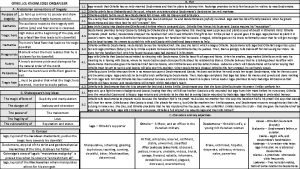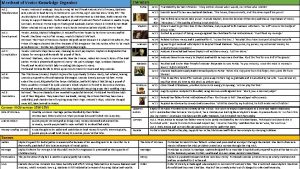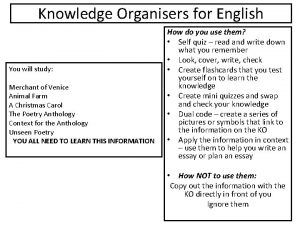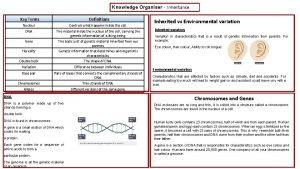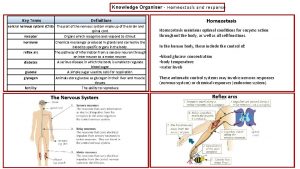Knowledge Organiser Particle model Key Terms Definitions State



- Slides: 3

Knowledge Organiser – Particle model Key Terms Definitions State of matter Matter is divided into three states: solid, liquid, and gas. Melting Change of state from solid to liquid. Freezing Change of state from liquid to solid Evaporation Change of state from liquid to gas. Condensation Diffusion Change of state from gas to liquid. Particles spread from a region of higher concentration to a region of lower concentration. Rate How fast an event, e. g. diffusion, is happening. Concentration The number of particles in a known volume. Particles All matter is made up of tiny particles. Pressure is formed when particles collide with the walls of containers. Pressure Changes of state Particle Theory All matter is made up of particles. Particle theory is used to explain the properties of solids, liquids and gases. Each of the states of matter is made up from particles, however the particles behave differently in each. Solids Liquids Gases Properties Fixed shape Cannot flow Cannot be compressed (squashed) Particles are close together Particles vibrate next to each other, but cannot move past each other. Diffusion Properties Take the shape of a container Can flow Cannot be compressed Particles are close together but able to move past each other. The spreading out of particles is called diffusion. This diagram shows how particles move from an area of high concentration to an area of low concentration. Properties Completely fill the space the occupy. Can flow Can be compressed. Particles move quickly in all directions, are far apart and have space to move in and out. Factors affecting diffusion There are 2 factors affecting the rate of diffusion: 1. Temperature: When temperature increases, particles gain more energy. They can then move and spread out at a higher rate. 2. Concentration: When concentration increases, the rate of diffusion increases.

Knowledge Organiser – Particle model Gas Pressure Gas pressure is caused by gas particles colliding with the walls of the container. A container also experiences pressure on the outside. Air particles on the outside collide with the outside wall. An imbalance between the pressure on the inside and outside can cause the container to change its shape. There are 3 factors affecting gas pressure: 1. Number of particles: The more gas particles inside the container, the more often collisions will occur, creating a higher pressure. 2. Temperature: If gas particles are heated up, they move with a higher speed and collide more often with the walls of the container, causing a higher pressure. 3. Volume: If the same amount of gas particles are put into a container of a smaller volume, pressure will increase because particles will collide more frequently with the walls when they have less space.


